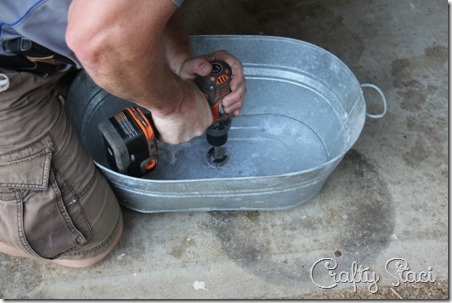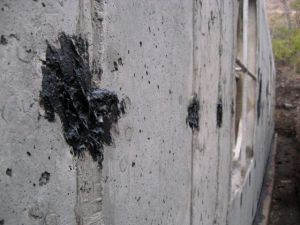BS”D
Shiur 5 – 2/6/19
1- We continued to learn about turning a כלי into a proper מקוה . This requires a two step process:
A- To puncture a hole in the כלי.

We discussed the various opinions as to the size of the hole. See ahead the Mechaber and Ramo.
B- To affix the כלי to the ground or to do something that shows that this כלי will no longer be used as a כלי. Such as patching the hole with cement.

2- We learned the Reb Akiva Eiger (see 10 פתחי תשובה ) that discusses the case of a box that was placed into a river. The process was to first puncture the box, thereby being מבטל the כלי. Afterwards, the hole would be plugged and filled with hot water. Prior to the tevila, the plug would be pulled out.
We will study this more in detail IY”H in the upcoming shiurim.
3- Here is the Machaber, Ramo, Shach and Taz.
Mechaber 7
The Mechaber now sets forth the parameters of what constitutes a vessel invalidating a Mikvah:
הלוקח כלי גדול, כגון חבית גדולה או עריבה גדולה, ונקבו נקב המטהרו – One who takes a large vessel, such as a large barrel or a large trough, and makes in it a hole that “purifies” it. וקבעו בארץ ועשהו מקוה, ה”ז כשר – And affixes it in the ground and makes it into a mikvah, it is kosher.
(וי”א דבעינן נקב כִשְׁפוֹפֶרֶת הַנּוֹד (טור והרא”ש בתשובה) וכן יש להחמיר) – And there are those that say that we are referring to a hole the size of a tube of a flask – size of two fingers), and so one should be stringent).
וכן אם פקק הנקב בסיד ובבנין, אינו פוסל והמים הנקוים בתוכו מקוה – כשר – In addition, if the hole is filled with lime and building stones, it does not invalidate it and the water that pools inside it is a kosher mikvah.
סתמו בסיד או בגפסית, עדיין הוא פוסל את המקוה עד שיקבענו בארץ או יבנה – However, if one clogs the hole with lime and plaster, it invalidates the mikvah, as it is now not considered to be a hole. Unless it is affixed in the ground or building.
ואם הוליכו על גבי הארץ ועל גבי הסיד, ומירח בטיט מן הצדדין, ה”ז כשר – And if it was dragged along the ground and on lime, and it was smeared by pitch along the sides, it is kosher.
הגה
מותר לעשותו על הגג, ובלבד שלא יהיה תוך כלי או אבן אחת שחקקו ולבסוף קבעו, אבל חבור אבנים הרבה לא מקרי כלי (תשובת הרשב”א סימן ת”ת) – One may place it on the roof, on the condition that it not be in a vessel or a single stone which was first hollowed out and only afterwards affixed there, but a combination of many attached stones is not considered a vessel.
——
ש”ך
:כה) בסיד ובבנין כו
כלומר תרתי בעינן חדא שיהא ניקב נקב המטהרו ועוד צריך שיקבע בארץ – Meaning, the vessel is valid as a mikah if it fills both criteria. One, by making a hole that “purifies” it. Two by attaching it to the ground. או שיהא בו הוכחה שהוא דבר של בנין ולא דבר של כלי – Or if the vessel has clear proof, it is obvious, that it is part of the building, and not a vessel.
ומ”ה אם פקקו בסיד ובבנין כלומר בצרורות וכיוצא בהן כעין בנין לא חשיב כלי כלל ולפיכך אינו פוסל את המקוה – Therefore, if the hole is filled with lime and building – meaning stones and similar object, thus making it as if it’s part of the building; it is not considered it a vessel. And thus, does not invalidate the mikvah. כלומר שהמים שבתוכו יחשבו מים שאובים – Meaning that we don’t consider the water inside the vessel as drawn water. As שאובים invalidates a mikvah. וה”ה דכשר לטבול בו – And one is allowed to immerse in it.
אבל כשנסתמו בסיד או בגפסית לבד – However, when if one clogs the hole with lime and plaster alone, without the stones כיון דאין דרך בנין באלו לבדם בלא אבנים או צרורות – Since it is unusual for these materials to be used for building without stones עדיין שם כלי עליו ופוסל את המקוה – It is still called, considered, a vessel and it invalidates it as a Mikvah. וכ”ש שאסור להטביל בתוכו – And of course one is not allowed to immerse in it.
ובתר הכי קאמר דאע”פ שלא קבעו בארץ דהיינו קבורה בארץ וגם לא בנאו אלא שהושיבו על הארץ ומירחו כשר – And afterwards the Mechaber goes on the explain – That although one did not affix it to the ground. Meaning, that not only one did not dig/bury it into the ground, and in addition, one did not build it into the ground; Rather, they just placed it on the ground and plastered it – it is valid as a kosher mikvah.
Plaster
אפי’ הושיבו ע”ג סיד וגפסית כיון שהסיד וגפסית על הארץ הם עומדין כארעא סמיכתא דמיא – And even in a case where one laid the vessel on lime or plaster on top the ground, because the lime and plaster and on the ground, it’s as if the vessel is itself on the ground. – And would thus be valid.
וכל שמירח הצדדים בטיט חשיב כקבוע וכשר ב”י – Thus is the opinion of the B”Y, that anytime the vessel was smeared by pitch along the sides it is as if it’s connect to the ground itself. And – it is kosher.

אבל הרא”ש והר”ש והרשב”א יש להם שטה אחרת בפירוש סיד וגפסית ומביאם ב”י וכתבו הט”ו לקמן סעיף מ’ ע”ש: – However, the רא”ש והר”ש והרשב”א have a different opinion on explaining the meaning of lime and plaster and the B”Y brings them down.
—-
ט”ז
ט) נקב המטהרו.
פי’ שע”י נקב כזה נתבטל שם כלי ממנו ואינו מקבל טומאה – Meaning that with a whole of this size the name vessel it loses its definition as a vessel and it does not become impure.

ושיעורו הוא כמוציא זית והוא פחות משפופרת הנוד ועי’ בסעיף מ’ דין נקב בצדיו – And its measurement is like a perforation with a hole large enough for an olive to emerge. Which is less than a vat spout hole.
